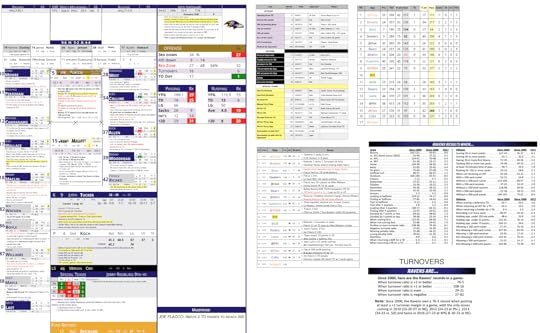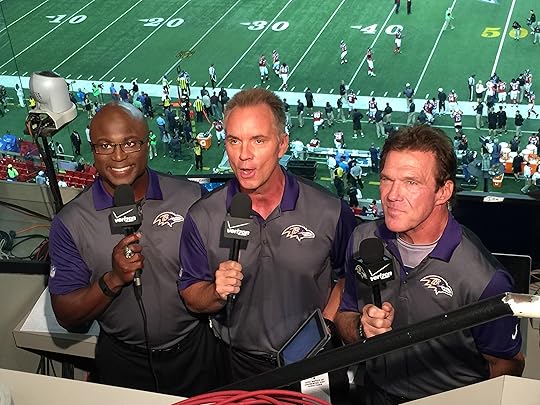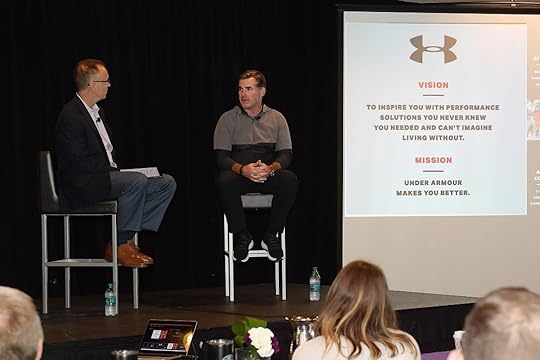Gerry Sandusky's Blog, page 4
July 30, 2018
Business and Presentation Lessons Learned from the NFL Broadcast Booth
Running a business, evaluating talent, leading others, communicating from the front of the room or in front of the business all share several things in common with doing play-by-play in an NFL broadcast booth:
They require your complete, undivided attention to do them well
You have to be both in the moment and aware of what’s coming next
You have no room for error and not a shot at perfection
And when things are going well, there is no place you would rather be. I know I feel that way.
Having broadcast a dozen seasons as the voice of the NFL’s Baltimore Ravens, I’ve gleaned some valuable insights from the broadcast booth that apply to my businesses of helping leaders evaluate their teams and helping professionals and organizations engage, amaze, and influence audiences.
I hope you find the insights helpful in your business and communication journeys too.
Show up Prepared But Be Willing to Move Off Script
The NFL broadcast booth requires more than ten fold the amount of time in preparation than in execution. A game takes about three hours. Getting ready for the game takes considerably longer.
Preparation is a Time Investment
Here’s a look at my game flipcharts. These take hours to prepare each week. They have information on both teams, every player, each team’s offense, defense, special teams, coaches, anecdotes, and milestones. It’s essentially a weekly business plan.
This is just one team’s offensive chart. You get the idea. They’re filled with information.

Here’s the catch: the preparation never perfectly matches everything that happens in a game. Sometimes something you don’t expect or prepare for becomes the driving force of the game story.
For example, you prepare copious notes on the visiting team quarterback and he gets hurt on the first drive of the game. Just like that, everything changes. You have to change with it.
Business & Presentations Work the Same Way
Sure, sometimes you can see big trends coming but other times the climate changes over night. A new tax, a disruption to a foreign government, an election outcome—all things out of your control—can force you to make a decision: stick with the plan or move off script.
If you stick with the plan it won’t work because what you planned for has changed. Your plan is largely irrelevant. Moving off script can save the day, but only if you have a script to move off of.
That’s why preparation is crucial, but trusting your instinct that your preparation no longer matches the circumstances is equally important.
Don’t Get Ahead of Where You Should Be
In the 2011 AFC Championship Game, with time running low in regulation, Ravens quarterback Joe Flacco threw a pass to the end zone where Ravens receiver Lee Evans got his hands on the ball. As soon as Evans touched the ball, I said, “Touchdown Ravens” because it looked like a sure touchdown. No sooner had I said that than a Patriots defensive back reached out and knocked ball from Evans hands.
Incomplete.
But I had already called a touchdown. I had essentially lifted the lid on euphoria, giving every Ravens fan a glimpse of making a trip to the Super Bowl.
I had to retract it. Or at least try.
“No, he can’t hold on. Incomplete.”
It only took me a nano second to reverse course. But I shouldn’t have had to. If I had let the pass attempt play out and stayed behind it instead of getting in front of it, I wouldn’t have put the audience through the agony of misleading them.
The Experience Applied to Business
As business leaders we make the same mistake when we get ahead of ourselves, make presumptions, put too much weight on expectations, and see with our hearts instead of with our eyes.
That one play taught me to follow just behind the ball and not get out ahead of it when I’m broadcasting a game.
Every business has a “ball” too, a driving force that everything else follows. What’s the “ball” in your business?
Whatever it is, stay just behind it and not out in front of it. Sometimes the ball takes strange bounces. Those moments are easier to adjust to if you haven’t erroneously committed to something that hasn’t happened yet.
Get into The Game, Not Just The Outcome
No one likes to lose. I get that. We all want to win. But you don’t get to win all the time. And sometimes, you don’t influence the outcome. But you always have influence over the input.
If I just put my best effort into broadcasts of the games I thought the the Ravens would win, I would be cheating the audience. I would also miss some amazing experiences.
It’s Not Just About Winning in Broadcasting or Business
Some of my favorite broadcasts have actually been in games the Ravens lost. I couldn’t control the outcome, but I was totally present, totally engaged, and on-point in the broadcast. That’s my job as a broadcaster. Be present. Be on target. Paint the picture.

In presentations, we can’t always control the quality of the audience. We can’t always control if the audience is going to get it.
In business, we can’t always control if we win or lose but we can control our commitment to the process.
I like to tell presenters that I coach that there are three types of presenters:
The ones who just get through it
The ones who just do it
The ones who get into it
I always get to choose how I approach a broadcast. I always try to choose option three: get into it.
You always get to choose your communication and leadership style. Whether you are leading a company, a department, or a workshop, the more you get into, the more your followers will too.
Sure, you’ll still face the sting of a disappointing outcomes sometimes, but you will never again face the sting of a disappointing input.
Call What You See, Not What you Expect
Listen to the Crowd
The crowd in a broadcast is far more than just the backdrop, the background noise. I consider the crowd a partner in a broadcast. The crowd has something to say. Sometimes the crowd speaks with pure emotion. Sometimes the crowd speaks from a place of insight. Sometimes it speaks from a place of frustration or from expectation.
Whether or not the crowd should know better, whether or not you agree with the crowd is irrelevant. It’s still important to listen to the crowd. Sometimes when the crowd is grumbling or booing early in a game, I’ll even say, “Listen to this crowd.”
The crowd always has an opinion. And the crowd wants to be heard.

Business Has Crowds Too
In business, the crowd can be an audience or a marketplace. Fail to listen to the crowd and before you know it, the crowd might tune you out too.
Let me underscore this point: The crowd isn’t always right. You don’t have to follow the crowd. You have to acknowledge the crowd.

It works that way in a business leadership and business presentation too. A lot of people who have lived in palaces, real and metaphorical, found themselves out on the street because they didn’t listen to the crowd. They didn’t factor the crowd into the conversation.
Crowds (Audiences) Matter in Business Presentations

In presentations, it helps to acknowledge where the crowd is coming from—even if you disagree:
“I know you are upset, but I want to share an insight…”
“I hear what you are saying, but here is what I see that you might not see…”
“If I’m hearing you correctly, then you want XYZ. I hear you. But if we do XYZ, we also run the risk of…”
The crowd doesn’t really want to be right. The crowd wants to be heard.
Listen to your crowd and make sure your crowd feels understood. A crowd that doesn’t feel understood becomes a crowd that stops showing up. Good luck with your business when that happens.
Rely on More Than Just Your Own Eyes
In 2017 the Ravens were playing on the road in Nashville against the Tennessee Titans. Midway through the first quarter, the Titans made a substitution at running back. They put a rookie named Adoree Jackson in the game. He wore number 25. I looked at my flipchart. I didn’t have a number 25 at running back for the Titans. My heart skipped a beat. Who in the hell is number 25?
Fortunately my spotter, the person who literally gives me another set of eyes on the field, recognized what was happening. The spotter was my son Zack. He quickly flipped to the defensive side of the flipchart, spotted number 25 and pointed him to me just as the Titans handed the ball to Adoree Jackson, number 25. I didn’t miss a beat because I relied on more than just my own eyes.

Leaders Can’t See Everything
Play-by-Play taught me that. Leading your organization or department is a lot like broadcasting a game. There are dozens of moving parts, countless considerations, a stream of split decisions you have to make. And you can’t see everything—no matter how much you can see.
Having people around me whose skill set, instincts, and talent I trust expands my ability to adjust to the unpredictable without getting caught off guard. And because I can trust in more than just my eyes, I can keep my eyes focused where they need to be, on the ball, the clock, and the flow of the game.
Your Leadership Vision
Where do your eyes need to be as a leader in your organization? Where are your blind spots?
Trust what you see, but know that you can’t see everything. Rely on more than just your own eyes.
This holds for presentations and speeches too. Ask the people around you who you trust how they see the situation, what they see as the key points, how they would handle approaching this group. They may see some things you are missing, some things that can make the difference between success and failure.
Final Thoughts
The NFL broadcast booth is a high pressure environment. Failing to prepare is a shortcut to failure.
Bt preparation alone won’t guarantee success. You have to make split second decisions, accept that you won’t be right every time, and still move forward to the next split-second decision, adjustment and unpredictable moment.
Critics will eagerly point out your shortcomings without having ever once done your job.
And if I’m guessing correctly here, what I face every Sunday in the broadcast booth whether in Baltimore, Denver, Nashville, or Cincinnati, probably sounds a lot like what you face every day and every week too—and certainly every time you stand in front of the room leading a presentation, conducting a meeting, or giving a speech.
Here’s to continuing the journey in business, in broadcasting, in presentations and striving to keep learning, keep growing, and keep getting better.
For now…the Hay’s in the Barn!
The post Business and Presentation Lessons Learned from the NFL Broadcast Booth appeared first on Presentation Skills Training | Gerry Sandusky.
July 11, 2018
How & When to Use Humor in Presentations
Humor covers a lot of territory. And most of it is tricky terrain. It can come across as playful or hurtful, insightful or biting. Planned and staged or organic and natural.
You can use it to make fun of yourself, self-deprecating humor or use it to make fun of other peoples.
You can use it to warm up an audience in a presentation or you can misuse it and turn off an audience.
Very different styles. Very different outcomes.
User beware.
All Humor is not Created Equal
Saying you want to use humor in a presentation is a little like going to an art gallery and saying you want to see paintings. There are a lot of different options.
There is no doubt, that in the right hands, it adds dimension, texture, and enjoyment to a presentation. In the wrong hands it can turn an hour or an afternoon into pure agony.
The How and The When
In this week’s video, I take a look at using humor in presentations. How to use it. When to us it. Who should use it. And who and when not to use it.
This week’s video might make you smile and laugh. Or it might make you flinch. Humor always comes with that risk.
Enjoy,
Gerry
The post How & When to Use Humor in Presentations appeared first on Presentation Skills Training | Gerry Sandusky.
June 25, 2018
Leadership Lessons from Kevin Plank
Recently I had the chance to moderate leadership session with UnderArmour CEO Kevin Plank. It was billed as a “fireside chat” at the Baltimore Ravens annual sponsor summit. For an hour I had a conversation with Kevin and folded audience questions into the dialogue.
Kevin was more than generous with his time and his insights on leadership in general and his journey in particular.
The leadership lessons Plank has learned from growing UnderArmour from start-up in his grandmother’s basement to a $5-billion dollar a year international brand can benefit anyone looking to grow a business or strengthen his or her position as a leader in their organization.

Here are a few of the thoughts and insights from Kevin Plank that I found most interesting:
The quotes are from Kevin Plank. The observations are mine.
Time Frame:
“We over-estimate what we can do in the short term; we under estimate what we can do in the long term.”
I have heard Microsoft’s Bill Gates say something very similar. When similar ideas emerge from multiple billionaire’s, it catches my attention.
Focus:
“As the organization grows it becomes exponentially important for the leader to narrow his or her focus. You have to edit. Otherwise proliferation swallows your time trying to do too many things for too many people.”
Later in the conversation, I asked Kevin what is the most important use of his time right now. He didn’t hesitate with his answer: “Find and use time for deep thinking.”
Courage:
“Plant your flag. Make a stand. Back your vision by putting your flag in the ground and making it happen.”
Faith in Your Ideas:
“Believing in possibility is crucial. Stop thinking it can’t happen. Why can’t it be us? Why can’t it be now? Marry that belief, that faith, with the courage of planting your flag in the ground. The acts of committing and believing great things can happen have power. Believe great things can happen and great things will happen.”
Experience:
I asked Kevin as a former college football player if he placed a higher value on hiring people who had experience playing team sports.
“Just because you haven’t played on a team doesn’t mean you aren’t going to be a great teammate. The key is finding people who understand the value of putting the good of the group above individual interests. That’s what makes great teammates.”
Enjoy the Journey:
In September of 2015, UnderArmour stock hit a high of $51.86 per share. In November of 2017 it hit a low of $11.61 per share.
“Not every year will be a great year. The tough years teach you that and make you look forward to the great years ahead and not just the great ones behind you. 2018 will be better than 2017. 2019 better than that.”
UnderArmour’s stock is currently double the price of its low point in 2017.
Building a Long-Term Brand:
“We started with a shirt that solved a problem. From there it grew into an idea. And from there it grew into a brand. Ideas have power.
“I’ve always had a dream of creating a brand that lasted the test of time, a 100-year brand. I’ve learned the key to long-term surviving and thriving is a willingness to refine, revise, even reinvent yourself every few years of the journey. And enjoy the journey.”
The post Leadership Lessons from Kevin Plank appeared first on Presentation Skills Training | Gerry Sandusky.
June 19, 2018
Get Your Audience to Shift from Wanting to Needing Your Presentation
Everyone you know has problems. Everyone you present to has problems. And everyone you present to is looking for solutions.
That’s where you come in.
Their Problems = Your Opportunity
One fast and effective way to connect with your audience is to position your presentation as a solution to the audience’s problem or problems.
Use your understanding of the audience’s problem or problems to establish a report.
But the bulk of your content should help your audience move from problem to solution.
Pain Relief
Helping people relieve their pain—whether that’s physical, financial, emotional, social, or psychological pain, will always position you as valuable since you provide the relief from the pain.
Give the audience a road map. Take the step by step from problem to solution. When you do that the audience motivation shifts from want to need. They want a good presentation. They need solutions to problems.
In this week’s video, I’ll show you a few simple steps to position your presentation as much more than just information. Instead, position it as a solution to problems. That will shift your audience to merely wanting to hear what you have to say to thinking it needs your presentation.
The post Get Your Audience to Shift from Wanting to Needing Your Presentation appeared first on Presentation Skills Training | Gerry Sandusky.
June 2, 2018
The Most Important Presentation You’ll Ever Give
You don’t always know when you have to give your most important presentation. That’s what makes it so tricky.
Throughout the course of your life and your career you will make a lot of important presentations. Some will seem similar, others wildly different. In some you’ll have the front of the room to yourself. In others you will share the platform with someone else or even a team of people.
Some of your presentations will raise awareness, some will raise money, some will raise emotions.
The Common Denominator
But all of your presentations will have one things in common: YOU!
The most important presentation you will ever make is the one where you introduce yourself to a group of influential people, whether that’s the admissions council to the school of your dreams, the vice-president doing a job interview, an investor weighing whether to write a check or not, or the Baltimore Ravens.
Not All Presentations are Planned
It happened last week to a young man named Tre Williams. Not long ago, Tre was walking home from school when he saw a house on fire. He went into the house and saved a woman’s life. When Ravens coach John Harbaugh heard about it, he invited Tre to practice and to take a tour of the Ravens facility.
Tre wasn’t expecting the next part. At the end of the practice, Coach Harbaugh called Tre into the team huddle to introduce himself and tell his story. The players loved him because Tre had the presence to be himself while presenting himself—in a presentation he was neither expecting nor “prepared” for.
Take a look and step into the team huddle with Tre:
We may not all get an invitation to walk into the Ravens team huddle, but we all get chances to present ourselves, and that’s the most important presentation you will ever make. That presentation, from walking in the door at work to addressing a group of investors, is an opportunity to build your brand and influence how others perceive you.
Your Brand
Do you know what your brand is?
Can you say it in four words or phrases?
I call it the Core-4 . Here’s mine:
. Here’s mine:
Insightful communicator
Engaging presenter
Empowering leader
Transformational coach
Once you know your Core-4 , your brand, it becomes much easier to consistently present yourself or your organization.
, your brand, it becomes much easier to consistently present yourself or your organization.
Over the years I have noticed that most professionals draw a blank when I ask two questions:
What’s your mother-in-law’s birthday?
What’s your Core-4
 ?
?The Step You Can Take to Learn Your Brand
I can’t do much to help you on the mother-in-law front. But if you would like to learn more about my Core-4 program for individuals and organizations, send me an email to gerry@gerrysandusky.com and we’ll start the conversation.
program for individuals and organizations, send me an email to gerry@gerrysandusky.com and we’ll start the conversation.
I can’t tell you what your next presentation will be but I can tell you that you will be the most important part of that presentation.
Once you have a clear brand target you’re trying to hit each and every time life—and not just your schedule—calls on you to present yourself, you will understand and embrace the power behind the most important presentation you’ll ever make.
The post The Most Important Presentation You’ll Ever Give appeared first on Presentation Skills Training | Gerry Sandusky.
May 21, 2018
What to do–and not do–with your hands in a presentation
When was the last time your really thought about your hands? If you’re like most people you never really think about them. You just use them. Until you have to give a presentation.
The front of the room seems to give your hands a bizarre life of their own.
Show of Hands
Have you ever started a presentation and suddenly felt like you didn’t know what you should do with your hands?
They can suddenly feel like they need an owners manual when you walk to the front of the room to give a presentation or a talk.
Suddenly they want to clutch on to each other, or grip the sides of a podium, or hide altogether. And none of that creates a very positive impact on your audience
The Owner’s Manual
There is something of an owner’s manual when it comes to what to do with your hands in a presentation. And it’s fairly simple and completely natural.
In this week’s video I’ll show you what to do and what not to do with them to create the best impression possible in the front of the room.
Put Your Hands to Use
Now please use one of your hands to good use. Go ahead and click the play button on the video below.
The post What to do–and not do–with your hands in a presentation appeared first on Presentation Skills Training | Gerry Sandusky.
May 14, 2018
Appearance Matters—But Not Always the Way You Might Think
This week, the sport of horse racing will hold the Preakness, the second leg of its Triple Crown Series. I have covered the Preakness for 30 years. A few years back I had the chance to cover the Belmont. And this year, for the first time, I covered the Kentucky Derby. My own Triple Crown!

Seeing each of these events up close, reminds me of how important context is when asked one of the most frequent questions I get regarding presentations: What do I wear for this presentation?
It Depends
The answer depends on the context.

The Kentucky Derby, The Preakness, and The Belmont are all horse races. They are all Triple Crown horse races, but they are not all the same context.
At the Preakness, you might wear a great hat, an expensive outfit, and new shoes—if you are going to the corporate village. But if you’re going to the infield for the concerts and the mayhem you wouldn’t dare wear that outfit because you would look totally out of place.
At the Belmont, people dress nice but not the the nines. It’s more of a business casual affair.
And at the Kentucky Derby you can’t overdress. You can’t wear something too loud our outlandish, but you can underdress. Go to the Derby in a pair of khakis, a polo shirt, and sneakers and you’ll look like you arrived from another planet. What were you thinking? You see at the Derby they dress up, way up, even in the infield.
Business Presentations Vary As Much as Triple Crown Races
Business presentations are a lot like the Triple Crown. It isn’t about always—or never—wearing a suit and tie or dress and hat. It’s about the context.
In Baltimore, if you wore a KFC bucket decorated with horses as a hat, you would fit in fine in the infield, but probably not in the high ticket areas. At the Derby, as long as the rest of your clothes are smart, you can pull that look off because of the context: you can’t over dress and you can’t dress too outlandishly.

Go-To Wardrobe Might Not Serve You
Too many presenters have their go-to outfits, the ones they always wear, no matter where they present. While that approach makes it easier to get ready, I’ll give you that, it also runs the risk of looking like the woman wearing one-of-a-kind custom made hat in the infield of the Preakness.

She would look completely out of place. But in Louisville, at the Derby, she looks perfectly in place.
The Questions Behind the Question
The answer to the question, “What should I wear to give this presentation?” should actually begin with a few other questions:
What is the context of the presentation?
Is this a casual audience or is this a conservative, formal organization?
What is the culture of this event or organization?
What is my personal brand as a presenter?
You’ll find the answer to what is best lies within the boundaries of those four questions.
You matter. The event matters. The audience matters.
More isn’t always better. Less isn’t always worse.
It just depends on whether you are at the business version of the Derby, the Preakness, or the Belmont?
The post Appearance Matters—But Not Always the Way You Might Think appeared first on Presentation Skills Training | Gerry Sandusky.
May 9, 2018
Take Care of Your Voice in Your Presentations
If you’re like a lot of professionals, you spent much of your career finding your voice. The last thing you can afford is losing it in a presentation.
But it happens all the time.
It isn’t about having a bad vocal cords or even bad luck. Yes, allergies, illness, colds, and fatigue can have a negative effect. So can dehydration.
The single biggest reason, however, that professionals lose their voice in presentations and in meetings has to do with how they use it.
Why You Lose Your Voice
It’s bad technique.
And not just speaking technique either. Breathing has a lot to do with why your voice can wear out by the end of a speech, a presentation, or a conference call.
Noise or Music?
Your voice is a wind instrument, and just like playing any instrument, knowing how to use it separates noise from music.
In this video, I’ll show you why you probably lose your voice in presentations, in meetings, or even after a long day of work, and I’ll show you how to avoid having it happen again.
The post Take Care of Your Voice in Your Presentations appeared first on Presentation Skills Training | Gerry Sandusky.
May 1, 2018
Play Your Aces in a Presentation
Recently I presented my full-day Presentation Transformation seminar to a group of highly talented executives at NatCon18, the national convention for behavioral health experts.
Early in the day unfolded, I noticed one woman knitting in the back of the room. It wasn’t a distraction. It was amazing. She did it effortlessly, without even thinking about it. And it didn’t distract her attention. It was part of who she was.
A few minutes later, one of the men in the group shared that he was an accomplished photographer. Another woman talked about her passion for dogs.
During a break, I had an amazing conversation about wine with one of the attendees. He knew a lot about wine. Another woman knew so much about southern cooking she made me hungry.
Another woman had lived and worked around the world—in places we don’t often think about, like Kosovo.
By the end of the day, the exchanges had revealed what I wanted everyone in the room to grasp: We all have special talents and abilities.
Some people can smile and light up a room. 
Some people can pull off card tricks.
Some people can paint or draw.
Some can do impersonations.
Some can fly planes.
Some play guitar.
We All Have Aces In Our Deck
I’m a big believer that we all have unique abilities. I call them the aces in your deck.
If you were playing poker and there was a big pot on the table, you would want the dealer to give you an ace—or two, thank you.

Audiences feel the same way. Audiences love it when a presenter pulls an ace from his or deck and plays it.
What Are Your Aces?
We all have aces in our deck. The problem is too often we take them for granted.
The woman who was knitting during my presentation could use a knitting demonstration during one of her presentations. Think of all the ways she could use it:

Demonstrate the benefits of repeating an activity over and over
Show how each individual activity fits into a larger plan
Give an example of how raw material in the right hands can become far more than what it appears
Demonstrate how output can never outpace input
You get the idea. Using knitting during a presentation can help make a point even when you aren’t talking about knitting.
Finding Your Aces
You don’t have to wait for someone to deal you aces. You already have them. You just have to start using them.
Write out a list of your unique talents or interests.
Have you hiked the Appalachian Trail?
Are you a vegetarian?
Do you rock climb?
Did you grow up with a father who was an NFL coach (one of my aces)?
Did your mom run for mayor of your hometown.
Are you a black belt in karate?
Have you run a marathon?

Think about how you spend your free time. What are you passionate about? What really makes your heart sing?
How to Play Your Aces
Now, dare to bring that passion to the front of the room in your next presentation. It doesn’t matter if your passion is directly related to the topic of your presentation. Your passion helps to bring the authentic you to the front of the room and your passion/talents are the perfect way to use stories and examples to either open your presentation or make key points.
Here’s an example:
I always teach audiences to limit their key points and subpoints in a presentation to no more than three. You don’t have to use three, just don’t use more than three. The reason is audiences won’t remember more than three key points, so why give them more than they can handle? Often, when you go past three, you either dilute your impact or make a mess of things.
To make that point, I will teach someone how to juggle.

Juggle one ball, well, that gets boring.
Juggle two, more interesting, but not that challenging.
Juggle three, now we’re talking about the need for skill and focus.
Juggle four—something I can’t do or teach—and the balls go flying everywhere. It all comes apart. Just like a presentation that tries to make too many points.
Bam. Mic-drop.
Your Aces Help You Stand Apart
Everyone has PowerPoint. Everyone can hold or wear a microphone. Everyone can put on nice clothes. Those things don’t help you stand apart from the crowd when you stand in the front of the room for a presentation, meeting, or speech.
But your talent for doing complex math, knitting, juggling, spelling, flying, cooking, or any of your other aces will help you stand out from the crowd.
And here’s the bonus payoff: When you bring something to the front of the room that you are comfortable doing, it makes you more comfortable and that always improves the quality of your presentation.
I encourage you, heck, I beg you: Dare to bring your passion, your pastime, your aces to the front of the room. I promise it will help you connect with your audience.
It will help you get key points across faster and more effectively, and it will add depth and interest to your presentation in ways PowerPoint never will.
So what are you waiting for? There’s a big pot at stake and the audience really wants you to give them an ace.
The post Play Your Aces in a Presentation appeared first on Presentation Skills Training | Gerry Sandusky.
April 19, 2018
Five Mistakes That Can Kill Your Presentations
We all want to deliver a perfect presentation. I’ve been chasing that one for years. Former Green Bay Packers coach Vince Lombardi said, “Perfection is not attainable, but if we chase perfection we can catch excellence.”
Not a bad destination.
Excellence, Not Perfection
Excellence comes not only from chasing perfection but also from avoiding the mistakes that can spoil the chase, or in this case spoil the presentation.
We all make mistakes. No avoiding that. And not all of them will kill your presentation. As a matter of fact, many won’t hurt your presentation very much at all. But there are a handful that are deadly.
Now, The Good News
Fortunately, you can avoid the mistakes that ruin presentations.
They’re pretty common. I like to think of them as giant pot holes in the road. Avoid them and you get to your destination in one piece. Hit them and you probably don’t get to your destination because you’re stuck on the side of the road.
The Mistakes To Avoid
There’s an endless list of mistakes you can make in a presentation. I’m fairly certain I’ve made most of them! But there are five you must avoid. These are the missteps that will ruin your presentation, just like a big old nasty pot hole can prevent you from getting to your destination.
In this video, I’ll share with you The Five Mistakes that will kill your presentations.
The post Five Mistakes That Can Kill Your Presentations appeared first on Presentation Skills Training | Gerry Sandusky.



